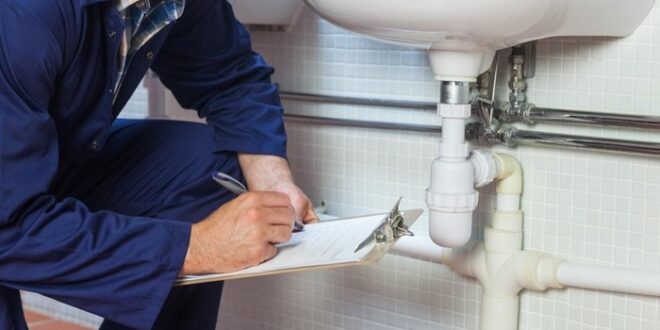Plumbers recommend having a home plumbing inspection every year or two—by professionals. It is an important part of home maintenance. Regularly inspecting your plumbing systems, you can avoid costly repairs and water damage.
While it is always best to hire a professional plumber to perform an inspection, there are some simple things that you can do to inspect your plumbing. It will help you stay on top of your home plumbing needs.
Here are 6 easy steps to perform a DIY plumbing inspection.
1. Water Heater
One of the most common plumbing help people need is hot water repairs in Melbourne. However, instead of rushing to call for an emergency plumber in Melbourne, you can regularly check up on your water heating appliances. It saves you the last-minute rush and trouble.
Here’s how you carry out a basic water heater inspection:
- First of all, the water heater should be free from other obstacles to inspect it.
- Avoid touching pipes or heating elements of the water heater without protection—gloves, eyewear, etc.
- Inspect if any connections or pipes of the heater show signs of leaks or corrosion.
If you can do this basic water heater inspection every often, you will know of any water heater problems before they become an emergency. And you can call for NLK Plumbing Hot Water System Repairs if the problem is bigger.
2. Home Faucets
You can make it a weekly routine to test each faucet, spigot, showerhead, and other water-dispensing fixture in your home.
The basic plumbing inspection for home faucets:
- Inspect for stuttering or strange noises.
- Check for low water pressure.
- Examine any water discolouration by turning on the hot and cold water pipes for each fixture.
- Check all bathtub and sink drains for warning indications, such as slow drainage or unpleasant aromas. These can point to the development of a clog in the drain line.
- Check your water metre after turning off all the faucets and taps. If the metre continues, you either have a significant leak somewhere or a malfunctioning metre. Whichever way, a professional needs to fix the issue before your water bill skyrockets.
3. Emergency Shut-off Valves
It is crucial to be aware of where each shutdown valve is placed throughout the house and to inspect them periodically.
You can simply:
- Try turning on each valve, and check if the faucets it serves are still able to dispense water.
- Repeat the test at each faucet after checking the shut-off valve where the service line leading from your water metre joins the house.
It is to see if all the shut-off valves are in working order.
4. Examine the Drains
Following the general plumbing system maintenance will lower your risk of recurring water blockages.
Needless to say, you have to include all the drains you usually use in your DIY plumbing inspection. Then follow the below steps:
- First, put water in the baths, sinks, and basins.
- Remove the plug and allow a good amount of water to drain through. It hints at any possible obstructions in your drain system.
- Now, look for slow drains or bad odours.
- Remember to check the floor drains also.
- Check for faulty clean-out plugs, as they might allow sewer gases into the house.
If there is a sign of a blockage, you can try to unclog it with a common plunger or a plumbing snake. But when the water makes guzzling sounds after draining, there must be a problem with venting that may need the help of a specialist.
5. Check Your Pipelines
Checking your pipes must be a part of your routine DIY plumbing inspection. Here’s how you carry it out:
- Look for damage or corrosion on the exposed pipes.
- Check the joints for weak or leaking seals.
- In case the pipelines are insulated, moist or peeling insulation is a sign of a leak.
- If the bathtub has access panels, remove the panel to check the drainage and shower lines for leaks.
- Do not forget about the pipes beneath the kitchen sink. Put water in the kitchen sink, remove all stoppers, and, if you have one, switch on the garbage disposal.
- All the water running through the drain could expose leaks you would otherwise overlook, along with ones in your garbage disposal.
- If water accumulates on the sides of the sink without waste disposal, the cause might be sediment in the pipelines. In this instance, you typically need a plumber because the drains need to be replaced.
6. Sewer Line
Sewer line repairs can become emergencies in an instant if proper care is not taken. And don’t be so sure your home doesn’t have this problem. Every home will have to face it at some time or the other.
You may regularly take steps to check on those sewer lines. It helps in prevent unexpected sewage or toxic waste from backing into your house due to a broken sewer line.
- To maintain the septic system’s cleanliness, use an enzyme additive frequently.
- Avoid growing trees or other shrubs with deep roots close to sewer lines.
- The landscaping should be at least 10 feet away from the sewer lines to avoid the interference of tree roots.
- Every year, have the sewer line cleaned.
- As soon as you suspect a problem, call for expert assistance.
To save yourself from unexpected sewer issues, have a regular maintenance check by a licenced professional once a year.
Conclusion
By performing a regular plumbing inspection, you can avoid many common problems with your home’s plumbing system. You can always hire a professional plumber, but there are some things you can do to inspect your plumbing.
Also, because this is a DIY, you can make it an even more regular thing—perhaps, every month or week.
Following these 7 easy steps, you can perform a DIY plumbing inspection and keep your home’s plumbing system in top condition. Nevertheless, always make time for professional plumbing inspection as well. Experts are experts for a reason, and they usually figure out even serious plumbing issues ahead of time.
If you haven’t done your plumbing inspection in a long while, you can reach out to NLK plumbing experts for a hot water plumber in Melbourne or any other plumbing issue.
 HammBurg Be informed with latest news, reviews, entertainment, lifestyle tips, and much more.
HammBurg Be informed with latest news, reviews, entertainment, lifestyle tips, and much more.




